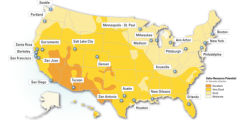The US Department of Energy (DoE) has announced an online resource for local governments that assists community leaders and local stakeholders in building sustainable local solar markets with best practices from 25 Solar America Cities.
 |
| These are the 25 selected Solar America Cities. They cover 16 states, and include 6 of the largest 10 cities in the USA. The cities vary in geography, population, and in the ‘maturity’ of their solar market. This is intentional, and allows DoE to identify and tackle barriers to solar in different markets. Map courtesy of DoE. |
The online publication, Solar Powering Your Community: A Guide for Local Governments, provides local governments with best practices enabling them to drive economic development, support clean energy jobs, and reduce carbon emissions by building a robust local solar market, DoE says.
“The Guide is based on successful projects in cities across the US, bringing together information, best practices, and step-by-step instructions into a single resource that can help local governments accelerate the adoption of solar technologies,” says Solar Energy Technologies Program Manager John Lushetsky. “The recommendations in the Guide have been successfully field tested in cities around the country, making it a valuable resource for any community that wants to reap the environmental and economic benefits of solar energy.”
The publication outlines best practices and lessons learned from 25 Solar America Cities and other local governments across the USA that have successfully increased solar energy use in their communities.
It also describes the country’s most innovative solar programms and policies, explains the benefits, provides implementation tips, and includes brief case studies.
Topics included in the solar guide include: strategies for solar initiatives, incentives, updating and enforcing local rules and regulations, engaging utilities, creative solar jobs and supporting economic development, outreach and education, and leading by example by installing solar on government buildings.



